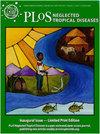对布基纳法索血吸虫感染流行人群血浆生物标志物的比较评估
IF 3.4
2区 医学
Q1 Medicine
引用次数: 0
摘要
血吸虫感染会导致泌尿生殖系统疾病,并伴有器官功能障碍、出血、疼痛以及对感染和癌症的高度易感性。及时、准确的诊断对于及时、适当的治疗和监测工作至关重要,与尿液寄生虫学检查相比,血浆生物标记物的使用具有重要优势,包括灵敏度更高,可使用同一标本进行多项检查。本研究旨在评估不同血浆生物标志物在西非布基纳法索流行人群中的诊断性能。对 406 份血浆样本中的血吸虫循环抗原(CAA)、游离血吸虫 DNA(cfDNA)、血吸虫可溶性虫体抗原制剂(SWAP)和可溶性虫卵抗原(SEA)的 M 类和 G 类抗体进行了检测。将每种生物标记物的检测结果与 CAA、复合参考标准(CRS)和潜伏类分析(LCA)的结果进行了比较。CAA和cfDNA检测结果显示,阳性样本的比例相同(29%),两种检测结果的一致性很高(84%,Cohen k = 0.62),与CRS和LCA结果的一致性相当。正如预期的那样,特异性抗体检测的阳性率较高(47%-72%),IgG 比 IgM 与三种参考文献的一致性更高。此外,当前感染与既往感染的 IgG 水平更高,ROC 分析确定了提高检测准确性的最佳临界值。这项研究提供了令人信服的证据,可为在血吸虫病流行地区根据检测目的、背景和可用资源选择最合适的尿路血吸虫病诊断血浆生物标记物提供依据。CAA或cfDNA检测均可用于患者诊断和流行病学调查,即使在没有尿液过滤显微镜检查的情况下也是如此,而抗SWAP或抗SEA IgG则可用于监测和综合监控针对贫困相关疾病的控制干预措施。本文章由计算机程序翻译,如有差异,请以英文原文为准。
Comparative evaluation of plasma biomarkers of Schistosoma haematobium infection in endemic populations from Burkina Faso
Infection with Schistosoma haematobium causes urogenital disease associated with organ disfunction, bleeding, pain, and higher susceptibility to infections and cancer. Timely and accurate diagnosis is crucial for prompt and appropriate treatment as well as surveillance efforts, and the use of plasma biomarkers offers important advantages over parasitological examination of urine, including increased sensitivity and the possibility to use the same specimen for multiple investigations. The present study aims to evaluate the diagnostic performance of different plasma biomarkers in endemic populations from Burkina Faso, West Africa. Schistosoma spp. Circulating Anodic Antigen (CAA), cell free S . haematobium DNA (cfDNA), class M and G antibodies against S . haematobium Soluble Worm Antigen Preparation (SWAP) and Soluble Egg Antigen (SEA) were measured in 406 plasma samples. Results of each biomarker test were compared to those of CAA, a Composite Reference Standard (CRS) and Latent Class Analysis (LCA). An identical proportion of positive samples (29%) was observed as a result of CAA and cfDNA testing, with a substantial agreement (84%, Cohen k = 0.62) between the results of the two tests, and a comparable agreement with the results of CRS and LCA. A higher positivity was observed, as expected, as a result of specific antibody testing (47%-72%), with IgG showing a higher agreement than IgM with the three references. Also, higher IgG levels were observed in current vs past infection, and ROC analysis identified optimal cutoff values for improved testing accuracy. This study provides compelling evidence that can inform the choice of the most appropriate diagnostic plasma biomarker for urogenital schistosomiasis in endemic areas, depending on the purpose, context, and available resources for testing. Either CAA or cfDNA testing can be used for the diagnosis of patients and for epidemiological investigations, even in absence of urine filtration microscopy, whereas anti-SWAP or anti-SEA IgG can be employed for surveillance and integrated monitoring of control interventions against poverty-associated diseases.
求助全文
通过发布文献求助,成功后即可免费获取论文全文。
去求助
来源期刊

PLoS Neglected Tropical Diseases
Medicine-Infectious Diseases
CiteScore
7.40
自引率
10.50%
发文量
723
审稿时长
2-3 weeks
期刊介绍:
PLOS Neglected Tropical Diseases publishes research devoted to the pathology, epidemiology, prevention, treatment and control of the neglected tropical diseases (NTDs), as well as relevant public policy.
The NTDs are defined as a group of poverty-promoting chronic infectious diseases, which primarily occur in rural areas and poor urban areas of low-income and middle-income countries. Their impact on child health and development, pregnancy, and worker productivity, as well as their stigmatizing features limit economic stability.
All aspects of these diseases are considered, including:
Pathogenesis
Clinical features
Pharmacology and treatment
Diagnosis
Epidemiology
Vector biology
Vaccinology and prevention
Demographic, ecological and social determinants
Public health and policy aspects (including cost-effectiveness analyses).
 求助内容:
求助内容: 应助结果提醒方式:
应助结果提醒方式:


